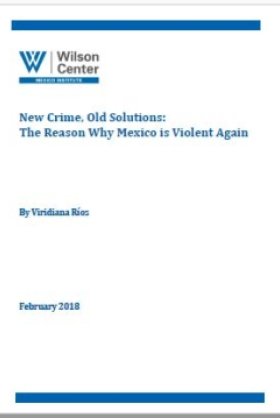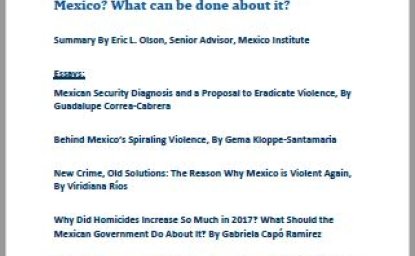New Crime, Old Solutions: The Reason Why Mexico is Violent Again


The upsurge in Mexico’s violence is the result of a multi-level, uncoordinated judicial system that has been incapable of controlling criminal networks that are increasingly fractured and geographically dispersed. Today’s crisis is the result of changes in the modus operandi of criminals that are not mirrored by changes in Mexico’s judicial and police institutions.
A war against drug cartels from 2006 to 2012 left Mexico with a fragmented organized crime landscape and with significant changes in the geography of violence. Security operations were concentrated in large cities, forcing criminal organizations to move to the periphery and to more rural areas.
Controlling this increasingly disorganized and geographically dispersed crime required a distinct set of tools that Mexico lacked. The country required a constant and robust strategy of territorial control and proactive intelligence to identify, not only new areas where organized crime operated, but most importantly, to foresee and contain the negative effects of capturing new criminal leaders. The fragmentation of criminal groups required a police force that operated in local and flexible departments, linked to civil society, and capable of capturing petty criminals. Mexico possessed none of these capacities. The slight benefits obtained from concentrating security operations in urban areas reached its limit, and the country was not capable of designing a strategy that could contain new criminal actors that emerged in their place.
The second increase in violence took place after 2012 and was fueled, for example, by the withdrawal of the Army from Michoacán in 2014, and the lack of local enforcement in the new trafficking routes that emerged after larger criminal groups were fractured. Similarly, violence increased when the Jalisco Cartel Nueva Generación organization grouped together many fragmented cells to fight against a Sinaloa Cartel that was also partially fragmented.
A new criminal landscape requires a new solution. Mexico’s new criminal networks are more viral and diversified. The tools to fight them must be, too. Because organized crime has diversified the activities in which it participates, enforcement needs to focus on those activities as well. One such criminal activity is the theft of fuel. In 2017 alone, the Mexican government identified 9,509 clandestine fuel extraction points, 38 percent higher than in 2016. The numbers for 2016 were already 30 percent higher than 2015. Mexico has seen increases in violence in territories surrounding pipelines, and worse, is seeing the emergence of more and more communities that profit from their alliances with criminal groups.
Furthermore, investments must be made to expand the capacities of public security institutions. The Armed Forces cannot continue doing the work that should be done by the police because by doing it, they create a perverse incentive to limit the professionalization of the police departments. Instead, resources should be allocated for hiring new police officers with better salaries and to eliminate those who do not meet the vetting standards.
Mexico also needs legal reforms so that individuals detained for possession of a firearm can be held in preventive custody. Prior to the judicial reform of 2008, Mexico’s penal code provided that civilians carrying large-caliber firearms designated for the exclusive use of the Army had committed a serious crime that required immediate preventive detention. Yet, since the adoption of the new adversarial criminal justice system, firearms possession does not merit preventive detention. Local authorities have argued that this is a severe limitation on the fight against organized crime, especially since the prohibition of possession of large-caliber firearms was one of the most effective ways to keep organized criminals off the streets.
Likewise, it is necessary to improve the coordination between state government and the federation. This would imply, among many other things, the implementation of a system of police quadrants, the surveillance of high-risk areas, and a closer relationship between local police and citizens. This does not mean the disappearance of local police (which is politically unfeasible) but the allocation of resources to improve the ones we have, and the implementation of penalties for municipalities and states that do not comply with the most basic security conditions.
Finally, Mexico would greatly benefit from implementing mechanisms that could show the incompetence of local authorities and penalize them for lack of results. Currently, despite multiple agreements between federal and state governments, there is not a source of real and updated information about the governors that have failed to pursue the implementation of judicial and police reforms. The minimal information that exists is not linked to any form of sanctions and is not public enough to create citizen pressure.
Overall, what Mexico needs is a local and targeted strategy to fight crime that is more fractured.
Author

Columnist, El Pais; Instructor of US-Mexico politics at Harvard Summer School

Mexico Institute
The Mexico Institute seeks to improve understanding, communication, and cooperation between Mexico and the United States by promoting original research, encouraging public discussion, and proposing policy options for enhancing the bilateral relationship. A binational Advisory Board, chaired by Luis Téllez and Earl Anthony Wayne, oversees the work of the Mexico Institute. Read more




